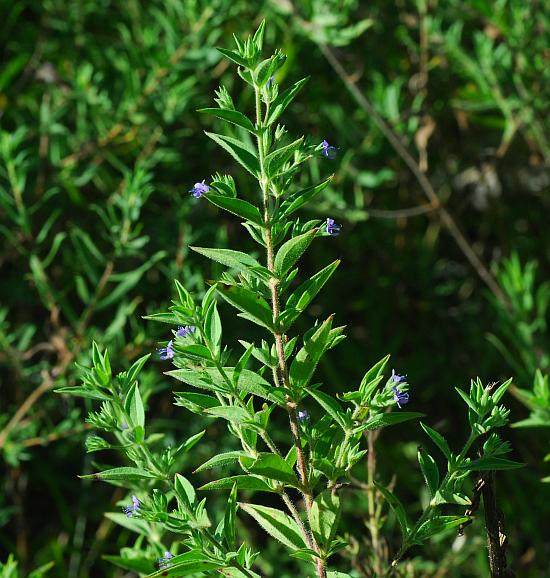Trichostema brachiatum L.
False Pennyroyal

Native
CC = 4
CW = 5
MOC = 64
© SRTurner
Trichostema brachiatum L.False Pennyroyal | |
 |
Native CC = 4 CW = 5 MOC = 64 |
© SRTurner |
|
Family - Lamiaceae Habit - Taprooted annual forb. Stems - Ascending to erect, to 50 cm, single from the base, branching above middle, densely pubescent with minute, gland-tipped hairs, often also with longer, nonglandular hairs, these usually only on 2 opposing sides.
Leaves - Opposite, simple, sessile or short-petiolate, descussate. Blades 1-5 cm long, 3-10 mm wide, narrowly elliptic to elliptic or lanceolate, angled or tapered at the base and tip, the margins entire or rarely minutely toothed, minutely hairy, the surfaces moderately to densely pubescent with minute, gland-tipped hairs, also with sessile glands, usually also with longer, nonglandular hairs, the venation of a midvein and usually a pair of ascending, somewhat finer lateral veins from the blade base, the secondary venation obscure.
Inflorescence - Axillary, of 2-6 flowers per node. Peduncles 2-4 mm long.
Flowers - Calyces 2.5-4.5 mm long at flowering, becoming enlarged to 3.5-7.0 mm at fruiting, actinomorphic or nearly so, slightly oblique, the lobes all similar, 1.5-2.5 mm long at flowering, triangular, the outer surface densely pubescent with a mixture of minute, gland-tipped and longer, nonglandular hairs, also with usually conspicuous sessile glands. Corollas 1.5-4.5 mm long, nearly actinomorphic, bilabiate, usually bluish purple, lacking lighter or darker markings, the tube cylindric to narrowly funnelform, expanded abruptly in the throat, the lowermost lobe only slightly longer than the others, the lobes all abruptly spreading. Stamens 4, slightly to moderately exserted, the filaments 2.5-4.5 mm long, straight or slightly arched, the anthers dark purple. Stigma 2-lobed. Ovary 4-parted.
Fruits - Nutlets 2.3-3.0 mm long, olive green to greenish brown or yellowish brown, inconspicuously and minutely hairy and with sessile glands toward the tips.
Flowering - July - October. Habitat - Glades, tops of bluffs, thin-soil areas of upland prairies, streambanks, gravel bars, roadsides; often on calcareous substrates. Origin - Native to the U.S. Lookalikes - Broadly, T. dichotomum, but this species has more distinctive, arching stamens. Vegetative specimens resemble species of Hedeoma. Other info. - This relatively inconspicuous species is found in the southern half of Missouri and also counties bordering the major rivers. It is probably more abundant in Missouri than any other state, though it occurs in scattered fashion throughout much of the Midwest and also in some southern states. It is considered rare or endangered in some of these outlying states. The plant is identified by its opposite leaves and small, blue or purple flowers in the leaf axils. The foliage is somewhat aromatic but not really minty. Photographs taken along the Current River, Shannon County, MO., 8-2-03 (DETenaglia); also at St. Joe State Park, St. Francois County, 9-10-2012, Shaw Nature Reserve, Franklin County, MO, 8-13-2014, and Don Robinson State Park, Jefferson County, MO, 9-1-2018 (SRTurner). |